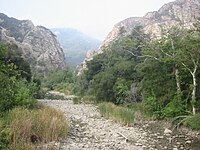Malibu Creek
| Malibu Creek | |
| Malaga Creek Maliba Sequit Creek Malibo Creek Topanga Malibu Sequit Creek |
|
| stream | |
|
Malibu Creek, dry river bed,
with the Goat Buttes in the background |
|
| Country | United States |
|---|---|
| State | California |
| Region | Los Angeles County |
| Tributaries | |
| - left | Medea Creek, Las Virgenes Creek, Cold Creek |
| Source | |
| - location | 4 mi (6 km) |
| - coordinates | 34°07′22″N 118°47′38″W / 34.12278°N 118.79389°W |
| Source confluence | Triunfo Creek and Lobo Canyon Creek |
| - elevation | 760 ft (232 m) |
| Mouth | Malibu Lagoon then Santa Monica Bay, Pacific Ocean |
| - location | Malibu, California |
| - elevation | 3 ft (1 m) |
| - coordinates | 34°01′54″N 118°40′47″W / 34.03167°N 118.67972°WCoordinates: 34°01′54″N 118°40′47″W / 34.03167°N 118.67972°W |
Malibu Creek is a year-round stream in western Los Angeles County, California. It drains the southern Conejo Valley and Simi Hills, flowing south through the Santa Monica Mountains, and enters Santa Monica Bay in Malibu, California. The Malibu Creek watershed drains 109 mi (175 km) and its tributary creeks reach as high as 3,000 ft (910 m) into Ventura County, California. The creek's mainstem begins south of Westlake Village at the confluence of Triunfo Creek and Lobo Canyon Creek, and flows 13.4 mi (21.6 km) to Malibu Lagoon.
Malibu Canyon is a chief pass though the mountains, and Malibu Canyon Road is a major north/south route connecting the coast to the inland valley. Malibu Creek starts at Malibou Lake, which is held back by the Malibu Lake Dam. Further downstream, the creek waterfalls 100 ft (30 m)over the Rindge Dam, then carves its final path into Malibu Lagoon.
The area around Malibu Creek was for centuries a major area of Native American life, and the boundary between the Chumash tribes, who lived to the northwest, and the Gabrieliño, to the south and east, was there.
The origin of the creek's name likely derives from the Chumash term U-mali-wu, which means "it makes a loud noise there". The Spanish recorded this as 'Malibu', and this spelling appears in the Topanga Malibu Sequit land grant on July 12, 1805.
Sections of the creek were dammed in 1903, 1922, and 1924.
It is estimated that steelhead (Oncorhyncus mykiss) populations within the Southern California Coast Steelhead Distinct population segment (DPS) have declined dramatically from annual runs totaling 32,000-46,000 adults to less than 500 returning adult fish. This estimate is based largely on the four major steelhead-bearing watersheds, Santa Ynez River, Ventura River, Santa Clara River, and Malibu Creek. Genetic analysis of the steelhead in all four of these watersheds has shown them to be of native and not hatchery stocks. A sand berm across the mouth of the Malibu Creek Lagoon blocks the stream to ocean-based steelhead except during the rainy winter season when high flows breach the berm and opens access to the estuary. The fish quickly reach an impassable barrier presented by the 30 m (98 ft) high Rindge Dam, restricting them to the lowest 3.2 km (2.0 mi) of more than 112 km (70 mi) of historic steelhead habitat. The dam, originally built for water storage and flood control in 1926, no longer functions as the reservoir is completely filled with sediment. Over the past decade several government agencies and non-profit organizations have been trying to remove the dam to restore access to upstream spawning habitat. In 1997, the southern Evolutionarily Significant Unit (ESU) of steelhead trout was added to the federal list of endangered species, with Malibu Creek as the southernmost boundary. Since 1997, the protected range of this ESU has been extended to the U.S./Mexican border. The National Marine Fisheries Service (NMFS) estimates that only 500 anadromous adults remain within this ESU (NMFS 2007). In summer, 2006, there was a massive die off of native and exotic fish and invertebrates in Malibu Creek, thought to be due to a combination of pollution, high temperatures and low oxygen. The steelhead trout population fell to zero by November, 2006. Fortunately, surveys in summer 2008 documented five returning adult steelhead over 50 cm (20 in), and over 2,200 smolts under 10 cm (3.9 in) were also recorded.
...
Wikipedia

